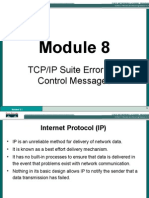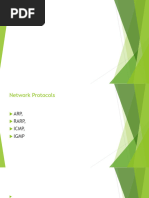ICMP Protocol Overview
Uploaded by
harryrpICMP Protocol Overview
Uploaded by
harryrp20/10/2010 ICMP Protocol Overview
Connected: An Internet Encyclopedia
ICMP Protocol Overview
Up: Connected: An Internet Encyclopedia
Up: Topics
Up: Functions
Up: Transport
Prev: Transport
Next: IGMP Protocol Overview
ICMP Protocol Overview
Internet Control Message Protocol (ICMP), documented in RFC 792, is a required protocol tightly integrated
with IP. ICMP messages, delivered in IP packets, are used for out-of-band messages related to network
operation or mis-operation. Of course, since ICMP uses IP, ICMP packet delivery is unreliable, so hosts can't
count on receiving ICMP packets for any network problem. Some of ICMP's functions are to:
Announce network errors, such as a host or entire portion of the network being unreachable, due to
some type of failure. A TCP or UDP packet directed at a port number with no receiver attached is also
reported via ICMP.
Announce network congestion. When a router begins buffering too many packets, due to an inability to
transmit them as fast as they are being received, it will generate ICMP Source Quench messages.
Directed at the sender, these messages should cause the rate of packet transmission to be slowed. Of
course, generating too many Source Quench messages would cause even more network congestion, so
they are used sparingly.
Assist Troubleshooting. ICMP supports an Echo function, which just sends a packet on a round--trip
between two hosts. Ping, a common network management tool, is based on this feature. Ping will transmit
a series of packets, measuring average round--trip times and computing loss percentages.
Announce Timeouts. If an IP packet's TTL field drops to zero, the router discarding the packet will
often generate an ICMP packet announcing this fact. TraceRoute is a tool which maps network routes by
sending packets with small TTL values and watching the ICMP timeout announcements.
Next: IGMP Protocol Overview
Connected: An Internet Encyclopedia
ICMP Protocol Overview
lincoln.edu/math/rmyrick/…/81.htm 1/1
You might also like
- Internet Control Message Protocol - Wikipedia, The Free EncyclopediaNo ratings yetInternet Control Message Protocol - Wikipedia, The Free Encyclopedia4 pages
- Internet Control Message Protocol: Technical Details Datagram StructureNo ratings yetInternet Control Message Protocol: Technical Details Datagram Structure8 pages
- CNS Tutorial 7 - Network packet analyzerNo ratings yetCNS Tutorial 7 - Network packet analyzer10 pages
- 3-6 PROTOCOLS-Internet Control Message ProtocolNo ratings yet3-6 PROTOCOLS-Internet Control Message Protocol16 pages
- Internet Control Message Protocol: ObjectivesNo ratings yetInternet Control Message Protocol: Objectives58 pages
- Internet Control Message Protocol (ICMP) Basics: On This PageNo ratings yetInternet Control Message Protocol (ICMP) Basics: On This Page7 pages
- Internet Command Message Protocol (ICMP)No ratings yetInternet Command Message Protocol (ICMP)10 pages
- Technical Details: ICMP Segment StructureNo ratings yetTechnical Details: ICMP Segment Structure7 pages
- Internet Control Message Protocol ICMP 2 PDFNo ratings yetInternet Control Message Protocol ICMP 2 PDF23 pages
- Assignment#4: Name: Ahsan Iqbal Reg# Sp17-BCS-044 Submitted To: Dr. Salman Iqbal Subject: Wireless NetworksNo ratings yetAssignment#4: Name: Ahsan Iqbal Reg# Sp17-BCS-044 Submitted To: Dr. Salman Iqbal Subject: Wireless Networks3 pages
- TN 206: Network Routers and Routing ProtocolsNo ratings yetTN 206: Network Routers and Routing Protocols51 pages
- Lecture4 P3 Computer Networks Protocols (UDP TCP ICMP)No ratings yetLecture4 P3 Computer Networks Protocols (UDP TCP ICMP)40 pages
- Networks and Security - Module 8 - TCP IP Suite Error and Control MessagesNo ratings yetNetworks and Security - Module 8 - TCP IP Suite Error and Control Messages13 pages
- TCP/IP Suite Error and Control MessagesNo ratings yetTCP/IP Suite Error and Control Messages28 pages
- Wepik The Role and Significance of Icmp Protocol in Network Communications 20240418134532uaqvNo ratings yetWepik The Role and Significance of Icmp Protocol in Network Communications 20240418134532uaqv8 pages
- Updated CN Module 4 Network Layer ProtocolsNo ratings yetUpdated CN Module 4 Network Layer Protocols13 pages
- Network Layer (Part 6) : Computer NetworksNo ratings yetNetwork Layer (Part 6) : Computer Networks31 pages
- LEARN MPLS FROM SCRATCH PART-A: A Beginner's Guide to Next Level of NetworkingFrom EverandLEARN MPLS FROM SCRATCH PART-A: A Beginner's Guide to Next Level of NetworkingNo ratings yet
- TCP/IP: Network+ Protocols And Campus LAN Switching FundamentalsFrom EverandTCP/IP: Network+ Protocols And Campus LAN Switching FundamentalsNo ratings yet



























































